Man-eaters are animals with the behavior of preying on humans. It doesn’t include incidentally eating a human that it killed in self-defense, desperate hunger, a single attack, or scavenging corpses. But all four cases may lead to animals eating human flesh and foster man-eating behavior.
Although many animals can attack humans, man-eaters regard human flesh as part of their diet. Therefore, they aggressively go hunting and kill humans for flesh.
Most documented man-eater cases involved lions, large crocodilians, polar bears, leopards, and tigers. But these aren’t the only predators who can attack humans if a chance presents itself. Various animal species also consider humans as usual prey. They include:
- Sported and striped hyenas
- Komodo dragons
- Various bears
Today, we discover the 12 most dangerous animals that are considered man-eaters.
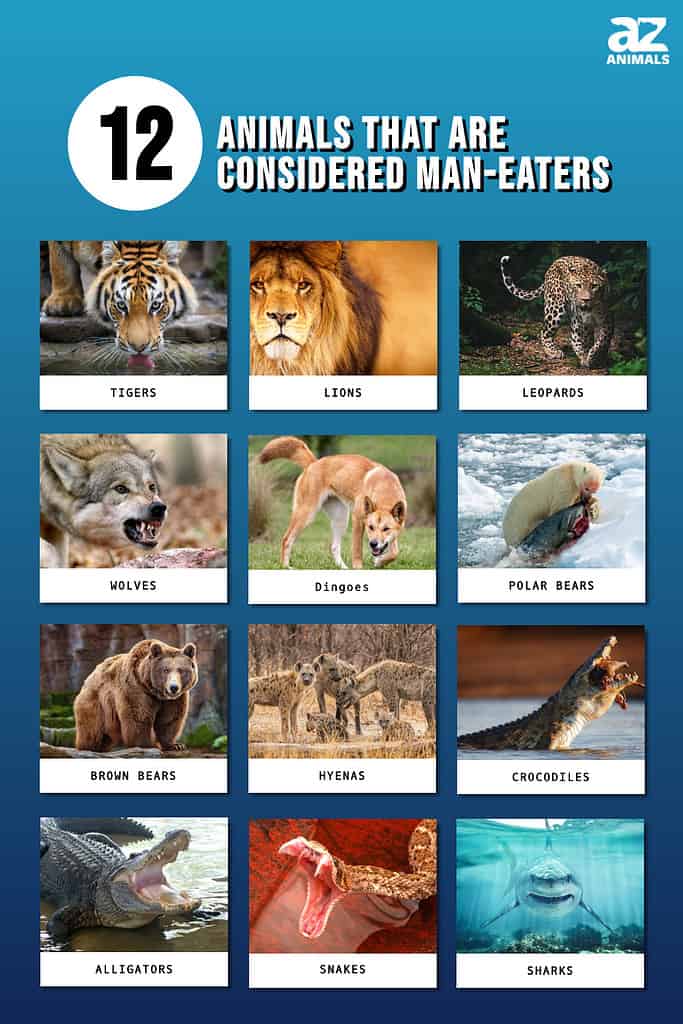
1 – Tigers

Unlike
leopards and lions
, man-eating tigers seldom go to human habitations to look for prey.
©Volodymyr Burdiak/Shutterstock.com
Tigers have killed more humans than any of the big cats. Moreover, they have directly attacked and killed more humans than any other wild mammal.
In the early 1900s, about 1,000 people died annually in India from tiger attacks. One notorious Bengal tigress reportedly killed 486 people in the country.
Between 1969 and 1971, tigers are reported to have attacked and killed about 129 people in India’s Sundarbans mangrove forest. The Sundarbans are inhabited by about 600 Bengal tigers that would, in the past, kill 50 to 60 people annually.
Unlike leopards and lions, man-eating tigers seldom go to human habitations to look for prey. Most of those attacked were reported to have been in tiger territory when it happened. Additionally, tigers mostly attack during daylight hours, unlike lions and leopards.
In 2008, tigers lost a significant part of their habitat due to Cyclone Sidr, leading to increased cases of big cats attacking humans on Sunderbans’ Indian side. The attacks were due to the tigers’ increased encounters with humans as they crossed from the Bangladeshi side to the Indian side.
2 – Lions

African lions
feed on humans as a supplement to other foods, not as a last resort.
©The Len/Shutterstock.com
Man-eating lions are known to aggressively enter human habitats at night and during the day to hunt for prey. Like tigers, lions may become man-eaters due to:
- Starvation
- Illness
- Old age
But cases of man-eating lions in perfect health have also been reported.
The most infamous case of lions eating humans was documented in 1898 in British East Africa, now known as Kenya. In this case, two huge maneless male lions reined terror on railway workers constructing a bridge over River Tsavo in today’s Tsavo National Park.
The lions are reported to have killed and eaten over 130 men, mostly Indian migrants. After this incident, the British prime minister halted the entire project and sounded the alarm. Eventually, the project’s head engineer tracked down and killed the enormous man-eaters. However, it took eight men to move each of the lions to the camp.
African lions feed on humans as a supplement to other foods, not as a last resort. For instance, lions mauled and ate three rhino poachers in South Africa in 2018.
3 – Leopards
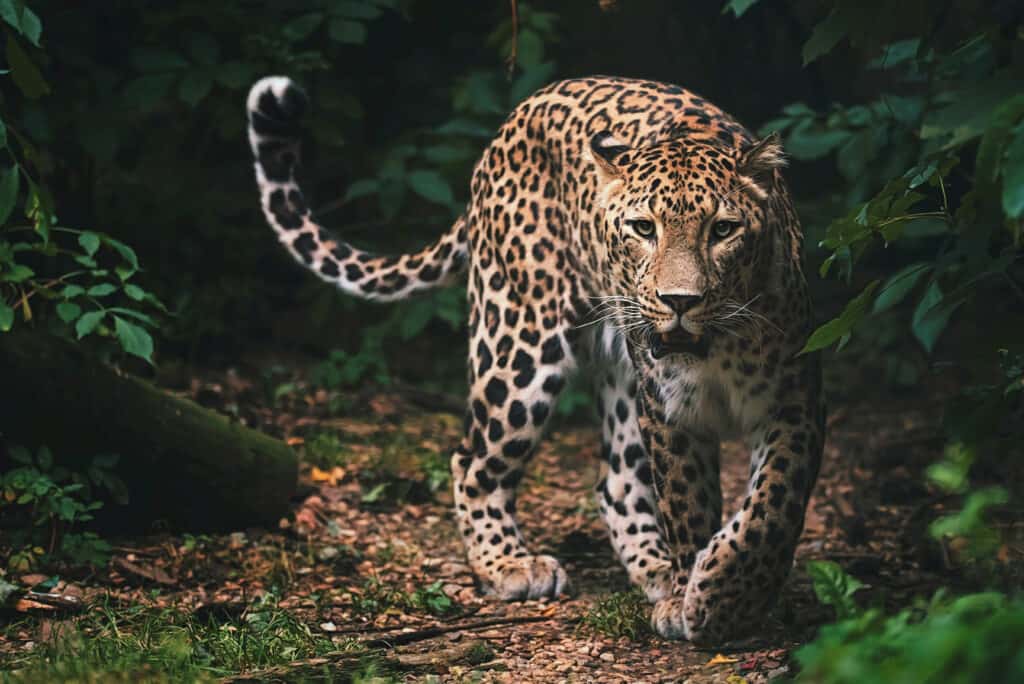
Man-eating leopards are bold and particularly difficult to track.
©Ondrej Chvatal/Shutterstock.com
Although man-eating leopards constitute a tiny proportion of the leopard family, they are a menace in some areas. Unlike tigers that turn into man-eaters due to frailty, leopards commonly do so after they scavenge on human corpses.
In parts of Asia, man-eating leopards have been reported to attack at night. They destroy thatched roofs and doors in search of human prey. Attacks in Africa aren’t as common as in Asia, but some occur in daylight.
Man-eating leopards are bold and particularly difficult to track. Thus hunting leopards is more challenging than other animals.
In India, a leopard is reported to have stolen and decapitated an infant in 2019.
Some of the notable man-eating leopards in history include:
- The leopard of Panar was a male leopard reported to have killed over 400 humans in Panar in India’s Almora district in the early 1900s.
- The leopard of the Golis Range killed over 100 humans in then-British Somaliland, now Somalia, in 1889.
- The leopard of Mulher Valley killed over 30 humans from 1901 to 1902 in the Mulher Valley of India.
- The leopard of Kahani killed about 100 people from 1857 to 1860 in India’s Seoni district.
- The leopard of Punanai killed over 12 people in Sri Lanka.
4 – Wolves
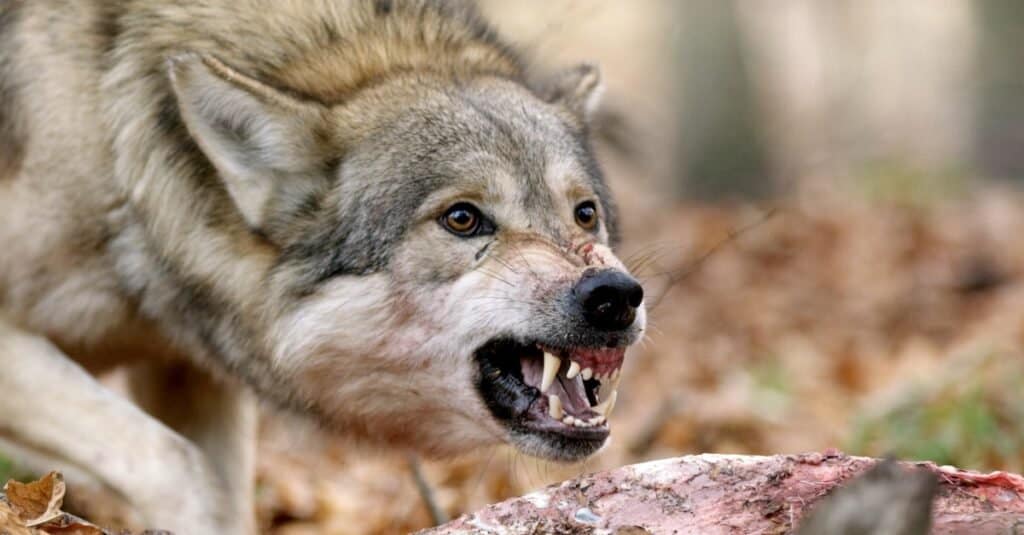
Wolves are legendary because of their spine-tingling howl, which they use to communicate.
©Peter Ivanyi/Shutterstock.com
Unlike other carnivorous mammals that may attack humans for food, wolves rarely kill people. For their predatory potential and size, wolves are among the least threatening carnivores. But male wolves are known to be more aggressive than females and may attack for many other reasons than for prey.
In rare cases where wolves have been reported to attack humans, most victims are usually children.
Habituation has contributed to man-eating wolf attacks due to living too close to human habitations. In addition, it leads to wolves losing their fear of people and may approach them too closely.
Habituation may also occur when humans knowingly entice wolves by offering them food or unknowingly don’t intimidate or scare the canines enough.
Studies show that wolves in captivity are bolder towards humans than those in the wild.
5 – Dingoes

The dingo (Canis familiaris dingo, Canis familiaris, Canis dingo, or Canis lupus dingo) is a legendary
dog
from Australia’s prehistoric lineage.
©iStock.com/Andrew Haysom
Dingoes are Australia’s legendary wild dogs, although they inhabit Southeast Asia too. The Australian ones are believed to have descended from their Asian cousins introduced to the continent about 4000 years ago.
The reddish or golden-colored canids live in packs of up to ten members. In some cases, the young male may live alone.
Dingoes rarely attack humans. Only two fatalities have ever been recorded in Australia. So naturally, dingoes are shy of humans and would do anything to avoid encountering them.
The most notorious dingo attack ever recorded was the disappearance of Azaria Chamberlain, a nine-week-old baby, in 1980. According to her parents, a dingo snatched Azaria from their tent when the family went camping in Uluru.
In yet another incident, a 14-month-old baby was saved from a dingo by her father in Australia in 2019.
6 – Polar Bears
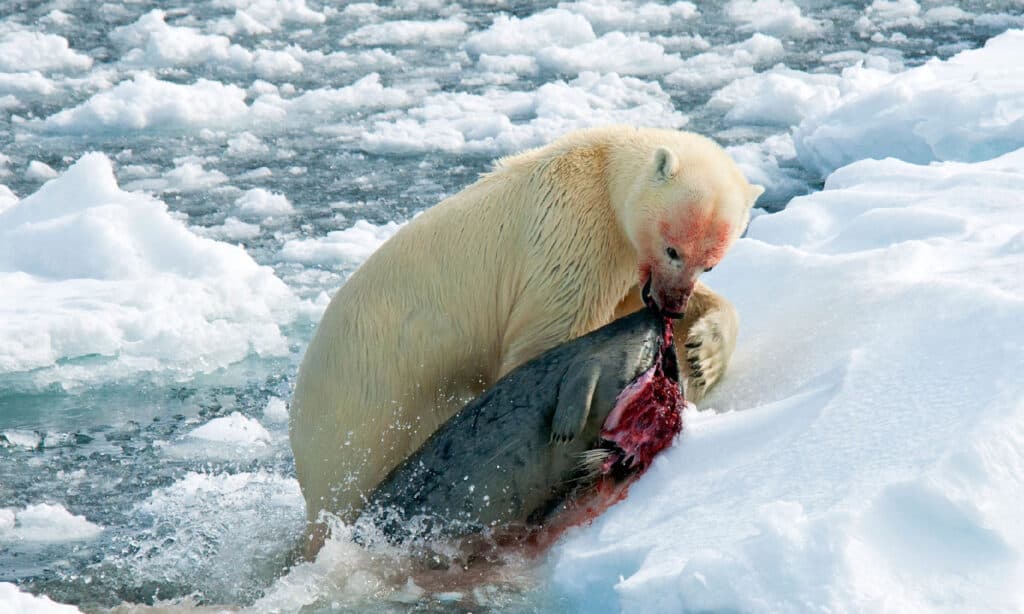
Polar bears usually hunt
seals
.
©iStock.com/AGAMI stock
Polar bears are giant shoreline- and land carnivores with immense strength. They are also known to be very intelligent.
Undernourished and young polar bears are known to hunt and eat humans. Although bear attacks on humans are rare, they can cause serious injuries due to their immense strength and size.
Like dogs, most polar bear attacks have nothing to do with predatory intent. However, the protection of cubs and territorial disputes can lead to fatal bear attacks.
Man-eating bear attacks aren’t common. But they may occur when prey is scarce or diseased. In such circumstances, they attack, kill, and eat anything they can find.
7 – Brown Bears

Grizzly bears
live in the western portion of the state of Montana.
©Perpis/Shutterstock.com
These bears have been reported to hunt for campers and hikers for prey in North America.
For instance, in Yellowstone National Park, Lance Crosby, a 63-year-old lone trekker, was attacked and killed by a grizzly bear in 2015. His body was later recovered in the park’s lake section in northwest Wyoming.
Similarly, in October 2003, Timothy Treadwell was killed alongside Amie Huguenard, his girlfriend. When it was discovered, the 28-year-old brown bear had almost fully eaten the couple. Clothing and human remains were later retrieved from the bear’s stomach.
In yet another incident, two geologists were killed by starving brown bears in Kamchatka in 2008 while working at a salmon hatchery. Their partially eaten remains were discovered, prompting authorities to dispatch hunters to disperse or cull the bears.
8 – Hyenas
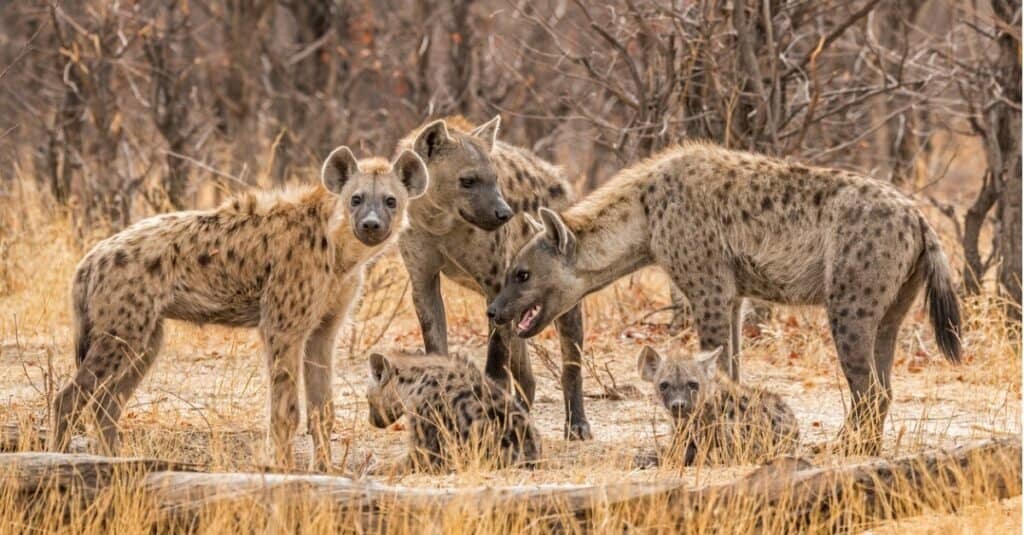
Like many predators, hyenas tend to attack children, women, and frail men.
©iStock.com/Franz Schallmeiner
Hyenas eat human flesh but generally fear humans. They are, therefore, less dangerous than most big cats. But both the striped hyena and the spotted hyena can kill an adult human. In addition, they can attack humans when prey is scarce.
Like many predators, hyenas tend to attack children, women, and frail men, although they may occasionally attack healthy males. Of the two species, the spotted hyena is more aggressive, predatory, larger, and more dangerous than its striped cousin.
The aardwolf and brown hyena don’t usually prey on humans.
9 – Crocodiles
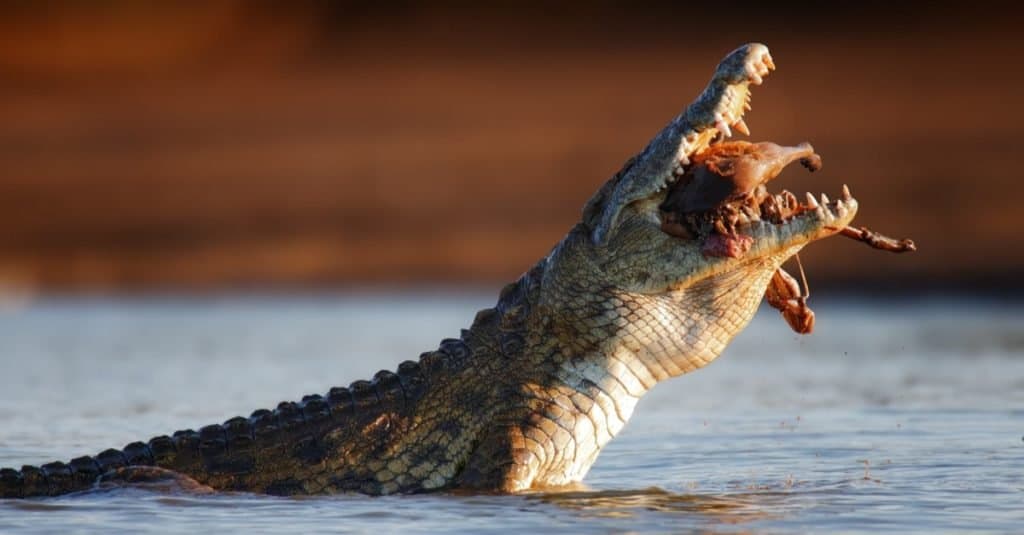
The Nile and
saltwater crocodiles
have attacked and killed more humans than any predator that preys on humans.
©Mari Swanepoel/Shutterstock.com
Crocodiles mostly attack humans in areas where the animals are native. The Nile and saltwater crocodiles have attacked and killed more humans than any predator that preys on humans. For example, Nile crocodiles attack hundreds of people in sub-Saharan Africa each year.
There are many crocodiles in East Africa. Unfortunately, their habitat overlaps that of poverty-stricken people without infrastructure. This has made crocodile attacks on these people more than other predators combined. One infamous man-eater crocodile ever documented is the Gustave.
In Australia, crocodiles have killed several people in the country’s tropical north.
The mugger crocodile is yet another predator responsible for many deaths in Asia yearly, although not as many as the Nile and saltwater crocodiles.
Although crocodiles are dangerous to humans, they don’t aggressively prey on them.
10 – Alligators
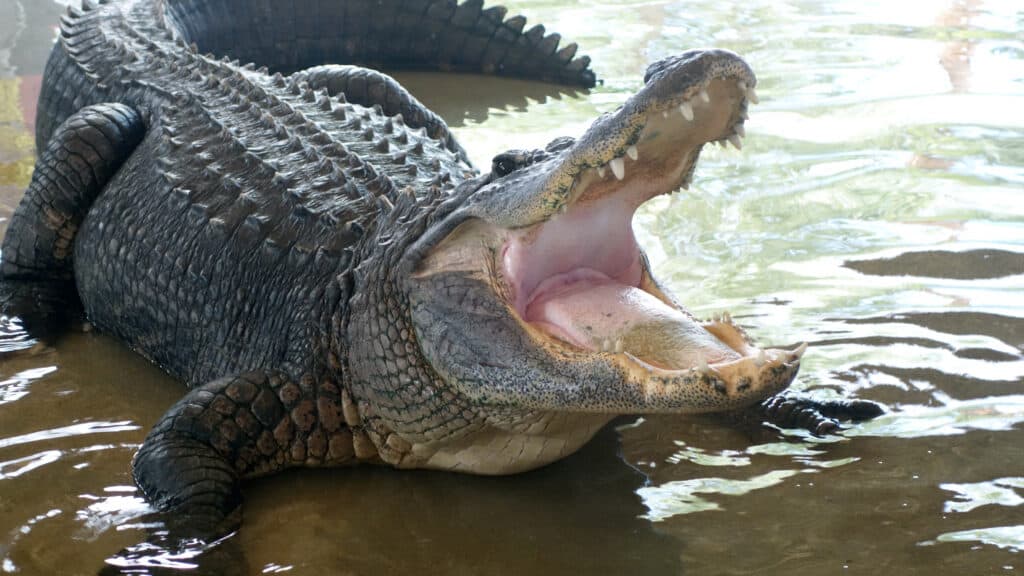
American alligators
seldom prey on humans.
©Ernie Hounshell/Shutterstock.com
Although they can kill prey larger than humans and are common in densely populated settlements, American alligators seldom prey on humans.
But several instances have been reported where alligators have opportunistically attacked humans, particularly the elderly, small children, and the careless.
Different from the more deadly Nile and saltwater crocodiles, most alligators evade human contact where possible.
The few reported alligator attacks on humans may not all have been in search of prey for the alligators.
11 – Snakes
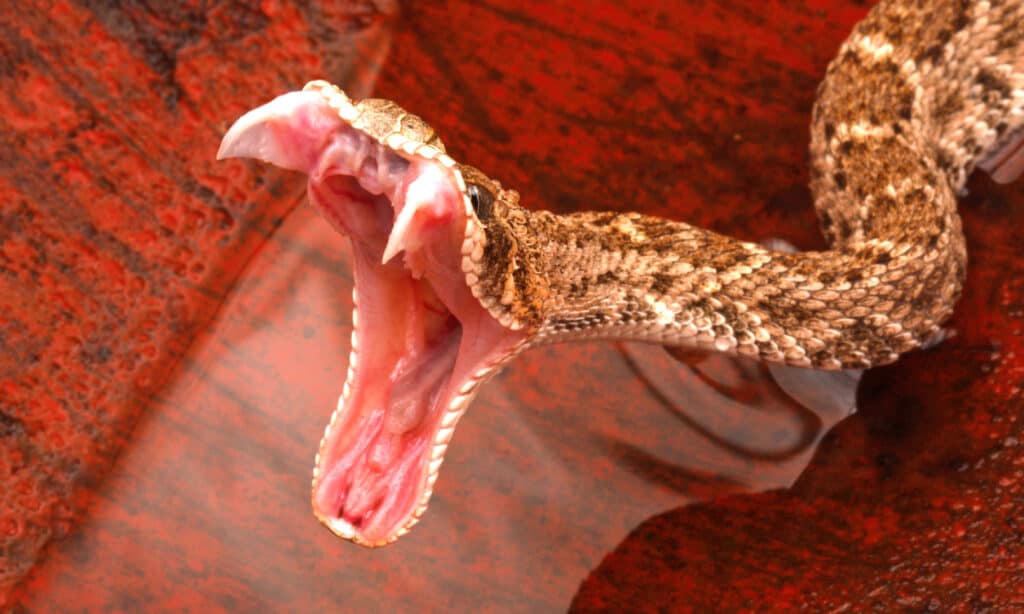
Large constricting
snakes
are known to constrict and swallow small children or infants.
©iStock.com/johnaudrey
Only a handful of snake species can swallow an adult human. Although some claims about giant serpents swallowing people exist, few have been verified.
In Indonesia, a 23-foot python swallowed an adult woman in 2017. Similarly, a reticulated python ate a 54-year-old woman in June 2018.
Constricting snakes can kill prey that is too large to swallow. Also, numerous cases have been reported where medium-sized Burmese pythons constricted and killed humans, including healthy adult men.
Large constricting snakes are known to constrict and swallow small children or infants. Some of the snakes reported to have attacked children include:
- The Burmese python,
- The African rock python
- The green anaconda
Over 26% of Aeta men in the Philippines have survived reticulated python attacks. The Aeta are Filipino indigenous people living on the Philippines’ Luzon island. They are historically hunter-gatherers.
As nonvenomous snakes, pythons ambush their prey. Since both pythons and the Aeta hunt monkeys, wild pigs, and deer, the Aeta are both prey and competitors to pythons.
In South Africa, a 20-feet long African rock python swallowed a ten-year-old boy in 2002.
In Australia, an amethystine python attempted to swallow an adult woman.
12 – Sharks
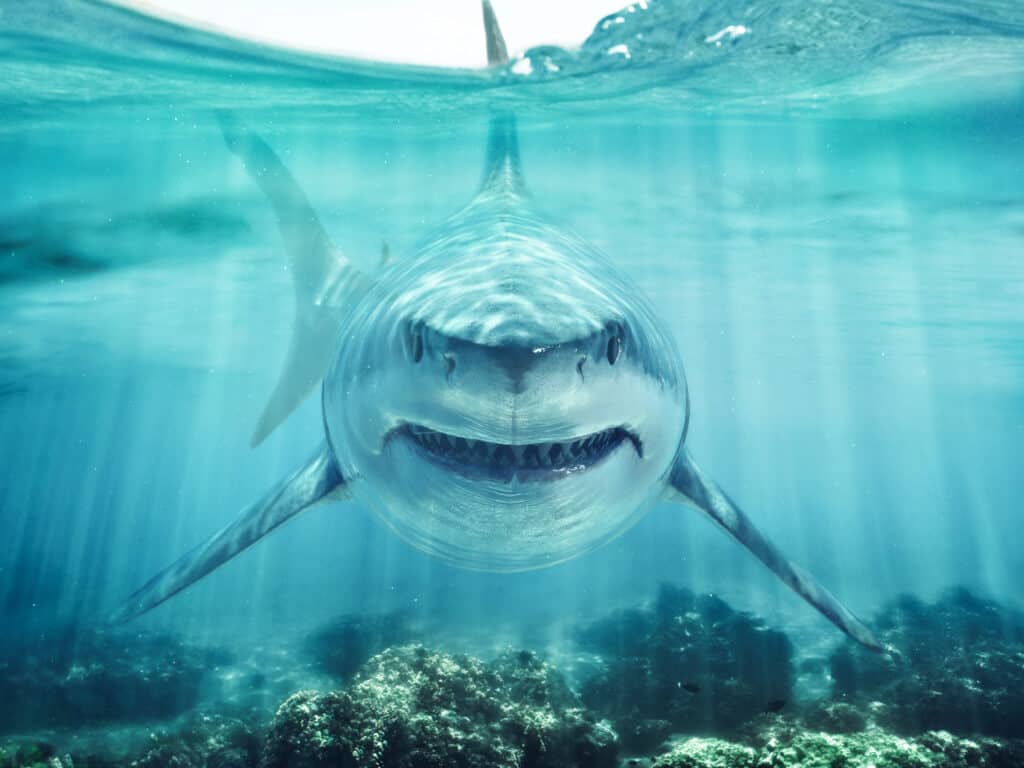
A
white shark
might attack someone on a surfboard because he may resemble a seal, its favorite meal.
©Digital Storm/Shutterstock.com
Contrary to what many people believe, only a few shark species really threaten humans.
The most dangerous species don’t discriminate and will eat anything. For example, an oceanic whitetip wouldn’t hesitate to eat a floating human after a shipwreck.
They may also bite out of mistaken identity or curiosity. For instance, a white shark might attack someone on a surfboard because he may resemble a seal, its favorite meal.
There are over 568 shark species, but only four have been reported to have fatally attacked humans. They include:
- The oceanic whitetip
- Bull shark
- The great white shark
- Tiger shark
Although the above sharks are powerful and large predators, it’s worth noting that unprotected divers have filmed them in open waters, meaning they don’t attack humans that often.
| Rank | Animal |
|---|---|
| 1 | Tigers |
| 2 | Lions |
| 3 | Leopards |
| 4 | Wolves |
| 5 | Dingoes |
| 6 | Polar bears |
| 7 | Brown bears |
| 8. | Hyenas |
| 9 | Crocodiles |
| 10 | Alligators |
| 11 | Snakes |
| 12 | Sharks |
The photo featured at the top of this post is © Dennis Jacobsen/Shutterstock.com
Sources
- Wikipedia, Available here: https://en.wikipedia.org/wiki/Leopard_attack
- Daily Mail, Available here: https://www.dailymail.co.uk/news/article-6941203/Leopard-decapitates-baby-snatching-cot-India.htmlhttps://www.washingtonpost.com/news/animalia/wp/2018/07/05/suspected-poachers-were-looking-for-rhinos-they-found-hungry-lions-instead-game-reserve-owner-says/
- NASA, Available here: https://earthobservatory.nasa.gov/images/19319/tropical-cyclone-sidr
- Washington Post, Available here: https://www.washingtonpost.com/news/animalia/wp/2018/07/05/suspected-poachers-were-looking-for-rhinos-they-found-hungry-lions-instead-game-reserve-owner-says/
- Science Direct, Available here: https://www.sciencedirect.com/science/article/pii/S0003347220301743
Thank you for reading! Have some feedback for us? Contact the AZ Animals editorial team.






